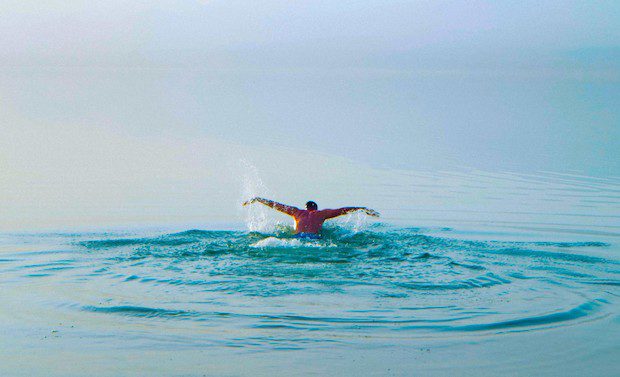At 2 am one morning she jumped off an 8-story building to her death.
Her four children and loving Dutch husband had no idea. He first met her at 20, and they loved each other so much. It was a forever kind of love.
After her tragic death he felt lost. Dark clouds took over. Evil thoughts entered his head. And he had four kids to explain it to and take care of.
One Sunday morning he wandered into a park alone.
His whole family still asleep at home. Many deep thoughts. So much grief. Suddenly he became attracted to a thin layer of ice on top of the water beneath. He finds an opening and jumps into the icy water.
It silences him. The voice of grief in his head turns off.
The ice-cold water makes him feel good. He can’t feel the cold. All he can feel is power. The next day he gets back in the icy water.
This becomes a habit.
A pattern starts to emerge…
Without the cold water he can’t escape his grief.
But he must, otherwise he can’t take care of his children. So the cold water becomes his only option to stay alive.
In the water there’s no thinking, no emotions … just survival. It’s a feeling of freedom he can’t describe.
We now know him as the iceman.
He has survived in freezing water for 2 hours. He has climbed barefoot past the death zone of Mt Everest in nothing but shorts. He has the world record for the furthest swim under ice.
Every limitation of the human body has been tested with his crazy methods. He couldn’t help his wife the day she took her own life and left behind their beautiful children.
Somehow now, though, Wim Hof is able to help millions of people around the world with his love of cold.
The world’s top achievers use hard times to change the world in bizarre ways. Here are six other habits they possess.
1. Getting drunk as a skunk on advice
Average people love to get drunk on advice.
They ask friends and family for their opinions on their goals. Top achiever Napoleon Hill noted that the #1 reason people fail to achieve their goals though is that they listen to dumb advice from friends and family.
Opinions are like buttholes — everyone has one.
Doesn’t mean someone’s opinion applies to your situation. Often opinions are tainted to keep you playing at the same level as your friends and family.
The truth is most of your friends and family aren’t top achievers. Perhaps none of them are. So their opinions and advice will hold you back, not accelerate you in the direction you want to go.
2. Create an anti-vision
The origin of this habit is unknown. It likely came from top achiever Charlie Munger who has a similar philosophy.
An anti-vision is where instead of setting a vision for your life that is exactly what you do want, you first write an anti-vision describing what you definitely don’t want.
My short anti-vision is I never want to work a job again, be told what to do, or have my writing be at the mercy of social media algorithms.
So I’ve designed my life accordingly.
Knowing what you don’t want helps you know what you do want. This then becomes a compass to head in the right direction.
3. The 5-Hour Rule
Entrepreneur Michael Simmons came up with the habit.
His study of the world’s top achievers led him to notice a pattern. They spent a minimum of one hour a day or five hours every workweek, learning or practicing a new skill.
This habit lasts their entire life.
Michael learned this concept from Benjamin Franklin, who famously set aside time to learn, so life wouldn’t get in the way. He liked to do this habit in the morning by reading and writing.
Benny boy loved self-improvement.
He even created a special club for artisans and tradesmen to gather and improve together. Every evening he’d experiment with the knowledge he gathered and ask questions to check his understanding.
The world’s top achievers are obsessed with self-education.
4. The 10 Reps Rule
Seth Godin is a high-achiever in the world of marketing.
He invented this rule. The philosophy is if you can do something once you can probably do it ten times.
Ten reps of a task means it’s highly likely it’ll become a skill. And it’ll feel awesome when you do, so you’ll do it without rewards or motivation.
Ten reps is a great place to begin.
5. The Paradox of Effort
Programmer Scott H. Young noticed this habit in high-performers.
On the outside high performance looks like luck or having the right connections. The paradox is, putting in loads of effort makes the work look effortless.
To make work look effortless they do an enormous volume of work behind closed doors, make practice a habit, overcome challenges, and keep going on days when they don’t feel like it.
Small amounts of consistent effort turns into big achievements.
6. A wild habit to finish with
This habit is named The Costanza Rule.
If you’re an old-timer like me you may have watched Seinfeld. The main character George Costanza always seems to find the answers to his problems when he does the opposite of what everyone tells him.
The habit top achievers have figured out is if you want uncommon results, you have to take what a normal person says and do the opposite.
The cliche advice like “find your niche” or “follow your dreams” gets you mediocre results. Humans are like parrots. We hear something that sounds good and then repeat it to death.
Ignoring common advice and doing the opposite helps you tread your own path. Try it and see what happens.


